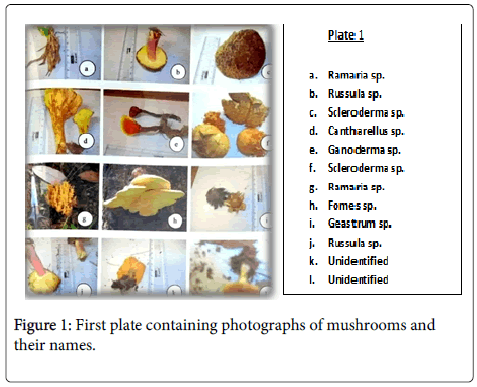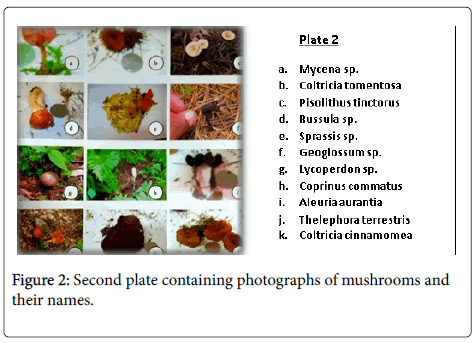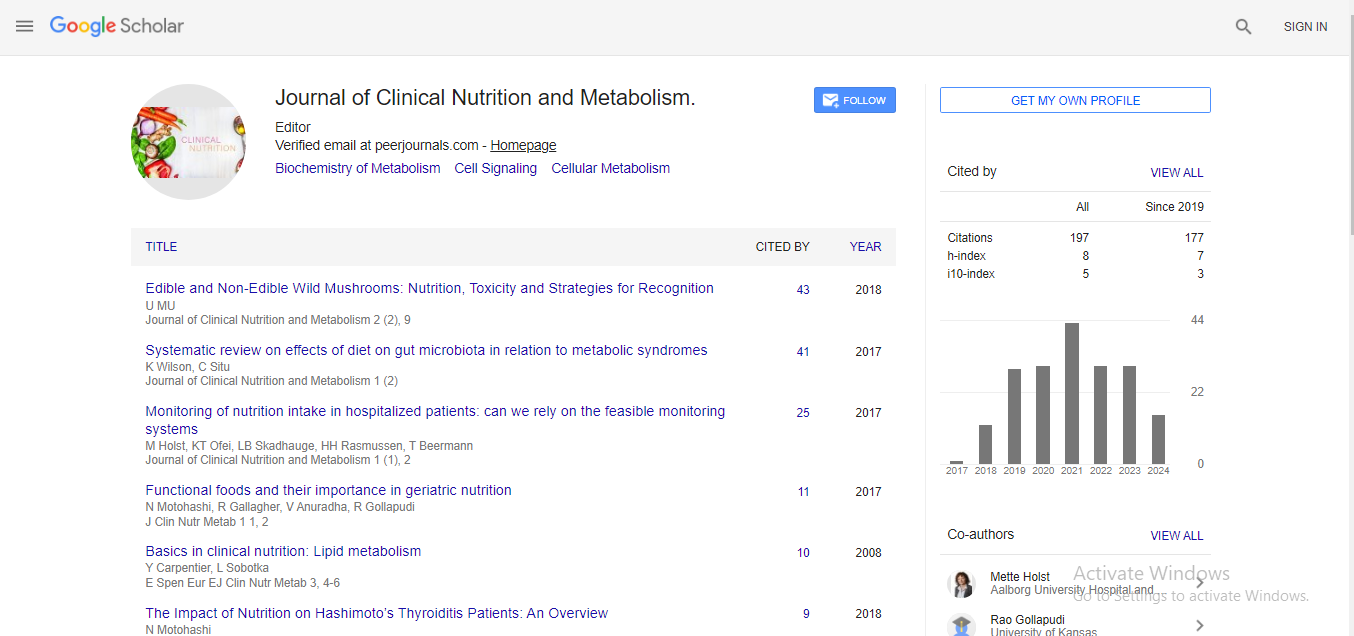Research Article, J Clin Nutr Metab Vol: 3 Issue: 1
Wild Mushrooms, their Toxins and Symptoms of Poisoning Found in Central Himalayan Forest of Jageshwar
Upadhyaya H1* and Upadhyaya ML2
1Lovely Professional University, Phagwara, Punjab, India
2Department of Botany, SSJ Campus, Kumaun University, Almora, 263601, Uttarakhand, India
*Corresponding Author : Himanshi Upadhyaya
Assistant Professor, Lovely Professional University, Phagwara, Punjab, India
Tel: 918755434985
E-mail: himanshiupadhyaya@gmail.com
Received: January 28, 2019 Accepted: February 11, 2019 Published: February 19, 2019
Citation:Upadhyaya H, Upadhyaya ML (2019) Wild Mushrooms, their Toxins and Symptoms of Poisoning Found in Central Himalayan Forest of Jageshwar. J Clin Nutr Metab 3:1. doi: 10.4172/JCNM.1000124
Abstract
Mushrooms are macroscopic fungi which have been a part of diet since ancient times. They are easy to collect and can be stored for a long period of time. Not all mushrooms are edible. While, some are poisonous, others may be inedible because of their color, texture or odour. However, they are also known to be medicinal and have been seen to cure ailments like inflammation, weak immunity and cancer. The collection is not easy since many of them look strikingly similar in appearance. Hence, one may accidently pluck a toxic or inedible variety and end up getting poisoning which can also be highly fatal at times. Some mushrooms are so fatal that a person can even die from exposure to the spores of the mushroom. Hence, it is essential that the collector has sound knowledge of the varieties and that they take precautions during collection. An attempt has been made to list down different edible and inedible varieties of mushroom found in Jageshwar forest of Kumaun Himalayas, Uttarakhand. Identification of species was done on the basis of morphological, microscopic and culture characteristics with the help of standard monographs. In all, 34 varieties of edible and inedible mushrooms were found, out of which 18 species were found to be toxic in nature. The signs, symptoms and possible treatment of various poisonous species in this region are also tabulated to make it easy to differentiate between different kinds of poisoning.
Keywords: Mushrooms; Poisoning; Himalayas; Jageshwar forest
Introduction
Kumaun region in the Central Himalayas enjoys varied topology of the Himalayas in the North and foothills of Tarai Bhabhar to the South, different climates from subtropical to alpine and diverse forest types which can be categorized as tropical moist deciduous, dry tropical, subtropical pine, Himalayan moist temperature, Himalayan dry temperature, subalpine and alpine scrubs [1]. Hence, the climate of this area is suitable for growth of varied species of mushrooms.
Mushrooms are well known for their delicacy since times immemorial and many a times, they have been seen to cause severe symptoms, sometimes even leading to death. It is essential to be able to differentiate between toxic and non-toxic mushrooms so that such circumstances can be avoided in the future. It has also come to notice that many lethal mushroom varieties were also used as a weapon of assassination in the past. In fact, it is said that emperor Claudius was murdered by serving him Amanita caesarea which was laced with Amanita phalloides for dinner. Mushrooms are also abused as psychedelics by many drug addicts who are looking for a cheaper way to get high. Mushrooms have also found a place in varied religious scriptures all around the world. The intoxicant “Somras” of Vedas is also said to be an extract of a mushroom variety [2]. The Greeks believed that certain varieties of mushroom provided strength to war heros. Romans considered mushrooms to be “Elixir of Life” [3].
Mushrooms grow in humid and varied temperature conditions. They are seen to grow on grasslands, coniferous forests, deciduous wood dumps, mixed wood forest, manured ground, mossy rocks and acidic soil. They are known by different terms on the basis of their habitats. For instance, species growing on grasslands are known as “Praticolous”, on the woodlands as “Silvicolors”, on woody debris as “Lignicolous”, on dung as “Coprophilous”, on mossy rocks as “Muscicolous” and on leaf litter as “humicolous”. The knowledge about the location and time of production of fruiting bodies is essential for identification of mushrooms. The time period for emergence of fruiting bodies along with temperature and humidity conditions is unalike for different genera and thus, it helps in identifying different varieties of mushroom.
By means of this paper, an attempt has been made to list down the different types of edible and inedible mushrooms found in the Jageshwar forest in Kumaun Himalayas, Uttarakhand.
Methodology
The current study is focussed on toxic mushroom species growing in the Jageshwar forest of Almora district in Kumaun Himalayas, Uttarakhand. Jageshwar is about 38 km from Almora city and is situated in the bank of river Jatayu, surrounded by dense Deodar forest. Quercus leucotrichophora, Pinus roxburghii and Taxus baccata are also found in moderation.
Method of collection
The site was visited for a brief period regularly. The specimens were dug out with the help of tools and collected in a bamboo basket. Preliminary observations such as habitat study, color change, smell along with colored photographs were documented before collection. It was ensured that the specimens were not collected in polythene bags since it hastens deterioration and putrefaction of samples.
The following precautions were taken in consideration
The specimens were in one piece, i.e. should not be broken into pieces.
Specimens were of different sizes and color.
Rotten specimens were not collected.
Each specimen was collected separately. Preservation of Specimens:
The specimens are taken to the laboratory after detailed observation. Preservation is done by drying them inside an electric oven at 40°C to 45°C for 8-10 hours [4]. The dried specimens are kept in separate sterilized polythene bags, which are further labelled with basic details.
Identification of species was done on the basis of morphological, microscopic and culture characteristics with the help of standard monographs. The literatures which were referred to are as follows:
The Mushrooms and Toadstools: A Field Manual by G. Kibby, Oxford University Press 1979.
The Encyclopedia of Mushrooms by Orbis Publishing London
The Amanitaceae by Ashok Kumar, R.P. Bhatt and T.N. Lakhanpal, Bishen Singh Mahendra Pal Singh, Dehradun, India, 1990. A Guide to the Mushrooms.
Their botanical position, mode of growth, structure, physiology, habitat ecology and economic importance by Louis C. C. Krieger, Asiatic Publishing House, Delhi.
Results and Discussion
Mushrooms are reproductive bodies of different fungi and belong to subdivision Ascomycotina and Basidiomycotina. Out of 70,000 species of fungi found around the world, 10,000 species belong to the mushroom category [5]. Dikaryotic mycelium or hyphae mainly constitutes the vegetation part of the fungi. Under required environmental conditions, mycelium gives rise to fruiting body which is also called sporocarp (Figure 1).
Ascomycotina is further divided into three classes viz. Plectomycetes, Pyrenomycetes and Discomycetes. According to Ainsworth and Bisby’s dictionary (1983), sub division Ascomycotina is further divided into 37 orders. All the large fungi are placed under the order Pezizales which has 13 families, 145 genera and 870 species [6].
The maximum number of mushrooms found growing in the natural habitat belong to the subdivision Basidiomycotina. The sexual spores are called basidiospores and are produced on basidium. This is divided into further two classes namely a) Hymenomycetes b) Gasteromycetes.
In India, a thorough systematic study on fungi was initiated by Butler [7]. Other scientists who have worked exclusively on various wide varieties of mushroom are Butler and Bisby; Ahmed; Natrajan; Kaul; Rawala, Verma et al.; Bhatt and Lakhanpal; Sagar and Lakhanpal; Harsh and Bisht; Bhatt et al.; Pande et al. and Vrinda et al.
The present study includes survey, collection, identification, drying and preservation of most toxic species of mushrooms in Jageshwar forest. In all, 34 varieties of edible and inedible mushrooms were found, out of which 18 species were found to be toxic in nature (Table 1).
| Edible Mushrooms | Inedible Mushrooms |
|---|---|
| Aleuria Arantia | Xylaria sp. |
| Coprinus comatus | Amanita aspera |
| Coprinus sp. | Coltricia tomentosa/cinnamonea |
| Ganoderma lucidum | Pisolithus tinctorus/allardii |
| Ganoderma applanatum | Clitocybe sp. |
| Geoglossum sp. | Daedalea sp. |
| Lycoperdon sp. | Gloeophylum sphaeriarum |
| Peziza sp. | Geastrum saccatum |
| Polyporous arcularis | Gyromitra sp. |
| Pycnosporellus fulgens | Helvella sp. |
| Russula sp. | Lepiota sp. |
| Sparassis sp. | Mycena sp. |
| Schizophyllum commune | Phellinus sp. |
| Thelephora terrestris | Peniophora fibulgena |
| Trametes versicolor | Pycnoporellus sp. |
| Xylobolus subpileatus | Ramaria sp. |
| Cantharellus sp. | Scleroderma sp. |
Table 1: List of toxic and non-toxic mushrooms found in Jageshwar forest, Kumaun Himalayas, Uttarakhand.
Collected mushrooms have been photographed and labelled in the plates 1 and 2 (Figure 2).
The toxin groups of inedible mushrooms and the symptoms of immediate poisoning are mentioned in the Table 2 below.
| Mushroom | Toxin Group | Signs and Symptoms |
|---|---|---|
| Amanita aspera (8) | Cyclopeptides like Alpha-amanitin, Phallotoxin and Ibotenic acid | Gastrointestinal irritant, liver damage, vomiting, diarrhoea, abdominal cramps, effect visible after 30-90 minutes of ingestion and recovery after 24 hours. |
| Xylaria sp. (Dead Man’s Fingers) [9] |
Phallotoxin | Dizziness, short breath, liver damage, insomnia, diarrhoea, back pain, irritation in eyes if contact is made. |
| Coltricia tomentosa, Coltricia cinnamonea | Irritant | Indigestable, stomach ache, nausea |
| Pisolithus tinctorus Pisolithus allardii | Non lethal | Non lethal but inedible |
| Clitocybe sp. [9] | Muscarine | Perspiration, salivation, lacrimation, urination, nausea, vomiting |
| Daedalea sp. | Non lethal | Inedible due to cork like texture and acrid taste |
| Geastrum saccatum | Irritant | Inedible due to their fibrous texture, diarrhoea |
| Gyromitra sp. [8] | Gyromitrin | Diarrhoea, neurotoxicity, lethargy, exhaustion, destruction of blood cells, bloated feeling, in severe conditions can result in liver damage eventually leading to death |
| Helvella sp. [8] | Monomethylhydrazine | Fatigue, bausea, diarrhoea, dizziness after 6-12 hrs of consumption, signs of liver toxicity after 36-48 hours. Can lead to death. |
| Lepiota sp. [9] | Amatoxin | Liver damage, gastrointestinal poisoning |
| Mycena sp. [8] | Hydroxy fatty acids like 7-hydroxy-8,14-dimethyl-9-hexadecenoic acid (may also contain psilocybin) | Inedible because of its rubbery texture and orange color which stains the surface that it touches. |
| Scleroderma sp. | Gastrointestinal Irritant | Abdominal pain, vomiting, diarrhoea, hypovolaemic symptoms, bloody stool, renal failure |
| Ramaria sp. | Gastrointestinal Irritant | Nausea, vomiting, diarrhoea, colicky pain |
Table 2: Mushrooms, toxin groups and signs/symptoms of their poisoning.
Treatment
After possible intoxication by any toxic mushroom species, the patient should be immediately rushed to the hospital. Stomach irrigation has to be performed and activated charcoal has to be administered to reduce absorption of poison in the stomach. Penicillin G. can also be given intravenously or intramuscularly [8-10].
Conclusion
Even though there are different species of mushrooms, it is difficult to differentiate between edible and non-edible varieties since some of them look very similar. Although only about 3% of mushroom varieties are poisonous, it is essential to know the toxic from the non-toxic in order to avoid accidental poisoning. The poisoning by wild mushrooms is more common in children than adults because they may accidently eat them. There is no rulebook for treatment of mushroom poisoning. The patient has to be treated according to their clinical symptoms. Some species are highly fatal and hence, precautions should be taken while collection. The ethno-botanical importance of mushrooms is highly regarded in some cultures and is passed as a word of mouth and may therefore result in collection of an inedible species in place of an edible one. It is very essential and highly recommended to be accompanied by an expert for collection of edible species in order to avoid any accidental poisoning. Proper identification is important to avoid casualties as well as for successful treatment of the poisoning. The discussed species are specifically very common in the Jageshwar forest which is a source of resources and means of livelihood for many communities living in the area.
References
- Champion HG, Seth SK (1968) A revised survey of the forest types of India. Manage of Publications. Delhi, India.
- Butler EJ, Bisby GR (1931) The fungi of India. Imp Council Agric Res India Sci Monograph I: 237.
- Chang ST, Miles PG (1992) Mushroom Biology: a new discipline. Mycologist 6: 64-65.
- Smith AH, Smith AV, Webber NS (1981) How to know the non-gilled mushrooms? Wm C Brown Company Publishers, USA.
- Hawsworth DL (1974) Mycologists Handbook. CMI, Kew, England, UK.
- Ainsworth GC (2008) Ainsworth & Bisby's dictionary of the fungi. Cabi, Oxfordshire, United Kingdom.
- Butler EJ (1905) Some Indian forest fungi. Indian For 31: 487-496.
- Ukwuru MU, Muritala A, Eze LU (2018) Edible and non-edible wild mushrooms: Nutrition, Toxicity and Strategies for Recognition. J Clin Nutr Metab 2: 2.
- Schnider SM, Brayer A (2000) Mushroom poisoning. Emergency Medicine: A comprehensive Study Guide, McGraw-Hill, New York, USA.
- Eren SH, Demirel Y, Ugurlu S, Korkmaz I, Aktas C, et al. (2010) Mushroom poisoning: retrospective analysis of 294 cases. Clinics (Sao Paulo) 65: 491-496.
 Spanish
Spanish  Chinese
Chinese  Russian
Russian  German
German  French
French  Japanese
Japanese  Portuguese
Portuguese  Hindi
Hindi 

